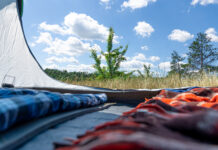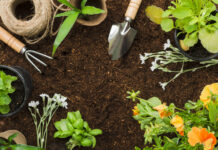From April 15-20, the Middle Eastern Student Center (MESC) celebrated the sixth annual Middle Eastern (ME) Week. Students took part in the activities to learn and celebrate Middle Eastern culture.
Sobhiyeh brings together the community in a traditional Middle Eastern breakfast setting
The first event of this week was Sobhiyeh, which was held on Monday, April 15, from 12 p.m. to 2 p.m. Walking into room HUB 355, the room was slowly filling up with energy and people. Tables were covered by a dark red cloth, rustic styled lanterns and plastic gems were the centerpieces, but the main attraction weren’t the shiny jewels, instead, it was the makeshift stage, which was composed of a rug and multiple pillows with intricate designs. In the back of the room, the aroma of vegetables, falafel and manakeesh with meat among other delicacies began to attract passersby. Music gently played, but the chatter of guests delighted by the food and atmosphere soon overpowered the music as seats quickly filled up. Art covered a corner of the room, many of them prints found online, but four pieces were originals created by MESC students. This was the start of Sobhiyeh, the kick-off event for ME Week, through different breakfast foods found throughout the Middle East.
With a warm welcome, Ali Saadat, MESC’s program coordinator, proceeded to give the background of the event, its meaning to MESC and then introduced two performers to the middle of the room, where the stage laid. Mehron Kazemi (‘16) played the tabla, a pair of drums, while Ali Arsala played the rubab, an lute-like instrument originating in Afghanistan. The audience were seated around the tables as the performers began to play their music, some grabbing more food from the back to better enjoy the show. The music created a welcoming environment, as the performers in front of the room continued to play for almost half an hour. People came in and out of HUB 355, but the room was never empty as the tables remained full of visitors enjoying the traditional cuisine.
Neeran Aranki, a second-year creative writing major and artist who had created two of the featured paintings, explained why she chose to feature women in her pieces. Of the first painting, which featured a mother, a son and an oud (a traditional pear-shaped, ukulele-like instrument), Aranki said, “This instrument between them served to show how music joins people together.” Her second painting featured a woman surrounded by bright colors, facing away from the people with a Middle Eastern scarf called a keffiyeh which, according to Aranki, represents “resilience, resistance, and the struggle of the Palestinian people and they wear it as a badge of honor.” Aranki added, “I wanted to add a splash of color because back home sometimes, it’s easy to see just darkness, but there’s also beauty within chaos and you can find your strength there.”
Meri Mkrtchyan, a third-year art history major, was the artist behind the “Evil Eye” and “Coffee” pieces, which were displayed next to Aranki’s painting. When asked about the painting referring to coffee, Mkrtchyan responded, ”It’s something culturally shared through the Middle East, it brings people closer together.” The second original piece featured a design that’s popular throughout social media, small shops or airports, the hamsa hand with multiple evil eyes handing from the hand. “It deflects evil…any jealousy thrown your away from others is stopped,” explained Mkrtchyan, “it’s a symbol of good luck.”
Through art, music and food of the event, MESC was able to educate UCR on the distinct cultures of the Middle East and bring its people together.
— Ashley Perez, CW
Fly with M.E. features renowned kite-maker showing his traditional craft
This year’s M.E. week also featured the center’s first kite-making workshop with Afghan kite master Basir Beria. The walls of HUB 269 were decorated with Beria’s original kite designs. Beria has created around 30,000 kites in his lifetime and designed the kites for the movie “The Kite Runner.” Beria informed the attendees about the history of kites and shared how he achieved his dream in 2006 of flying a kite on top of the Great Wall of China. “I eat kite. I drink kite. I sleep kite. I fly kite,” he said.
During the workshop, Beria passed out partly completed kites so attendees could focus on the last steps in setting up their kites. The event ended with attendees heading out to the HUB Lawn to fly their kites. “We always want to do different things,” said MESC program coordinator Ali Saadat on MESC’s first kite-making workshop. Saadat had personally always wanted to try kite making. “If we can do something new, we can do it.”
“Flying is our real game. It’s Afghan,” Beria told the Highlander. “You have to have the passion for it.”
— Martha Delgado, SSW

MESC Nooner livens up a Wednesday afternoon
Many students gathered at the Bell Tower for the MESC Nooner on Wednesday, April 17. After a welcome by MESC program coordinator Ali Saadat and MESC social media manager Ali Al-Shaher, the nooner began with a performance by the Lebanese Social Club. The featured act for the nooner was Al Salam Dabke, a traditional Palestinian dance team from Chicago, Illinois. Throughout their performance, students joined in the dabke on the stage with the group and off stage on the sides of the Bell Tower.
“It’s a lot of work and a lot of time on our hands but at the same time once we see everyone here and showcasing our culture, it becomes worth it,” said Yasmeen Dabbas a fifth-year and MESC program coordinator who was part of the planning process. “We always see different spaces but once we see our own culture showcased it means a lot.”
— Martha Delgado, SSW

Dine with M.E. successfully displays the richness of Middle Eastern cuisine
Dine with M.E. was the penultimate event of the week, displaying a variety of Middle Eastern dishes in the Aberdeen and Inverness Residential Restaurant on Thursday, April 18.
The menu prominently featured Afghan dishes such as Afghan Kofta Kabobs on rice and Afghan Salata, or salad. The chefs at the World’s Fare station also cooked falafel, tabouleh and to top it off, halal chicken shawarma.
I had a little bit of everything, and though some things could have used more garlic (everything can use more garlic), it was an excellent starter for anyone who may be unfamiliar with the richness of Middle Eastern food. My favorite was the salata — its cool, refreshing crunch and strong use of lemon was as enjoyable as it sounds.
For dessert, the Dining Hall served baklava, a popular Middle Eastern pastry, featuring layers of Filo filled with nuts and sweetened with honey or syrup. Served in a large, triangular slice, it was yet another good introduction for those learning about the culture.
“I sincerely believe knowing the food is knowing the culture,” said Samir Al-Alami, a third-year political science major. Al-Alami enjoyed the event, stating “I loved it,” and adding, “it’s important to see that your culture means something, that it matters to people.” He went on to express the importance of explaining to people the importance of a culture different to their own and finding common ground with others.
The festivities closed with the Remembering the Refugees event held by the Epsilon Alpha Sigma sorority, also known as the Empowered Arab Sisterhood, to raise money for the education of Syrian refugee children in Lebanon.
— Evan Ismail, SSW







